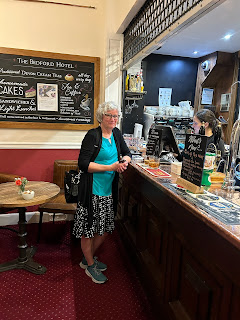Our Itinerary reads: Explore Bath, a city of elegant Georgian buildings in a distinctive golden stone. Tour the wonderfully preserved Roman Baths. Head to Cardiff, where you'll take a sightseeing tour of the city before touring Cardiff Castle, a medieval castle fabulously renovated in Victorian Gothis style. Dine in your hotel this evening.
Beautiful buildings like this everywhere with gorgeous flower boxes and or planters in front. These two ladies (cousins), were part of our group. Their luggage didn't make it to London, so they did lots of scrambling until their luggage was found and caught up with them.
The buildings were golden.
We noted beautiful walkways, as we took a walking tour in Bath.
Sally Lunn's, the oldest house in Bath, built 1482. Sally lived there in 1680. It's a Tea and Eating House.
The buildings were golden.
We noted beautiful walkways, as we took a walking tour in Bath.
Sally Lunn's, the oldest house in Bath, built 1482. Sally lived there in 1680. It's a Tea and Eating House.
You walk above the level of the baths and get a great view of the baths and some of the city. You walk on the same level as the baths and stop at various listening stations to learn more by using your voice box as part of your entrance fee.
You continue walking below the level of the baths where lots of artifacts are stored. Much has been excavated and studied. They've even found mounds of money. It's dark on this lower level so pictures are a bit of a challenge. AND, it's rather crowded as people continue to listen and stop at various stations. You could spend hours if you stopped at every station and listened to the entire recording. We were a bit hemmed in by our time table to grab lunch if wanted and be back at the coach at the appointed time, so we cut this area a bit short and headed to the gift shop.
We headed to Cardiff, the capital of Wales for a walking tour of the city. This is Aneurin Bevan 1897-1960. He's Welsh, and was The Minister of Health. He spearheaded the British National Health Service. During World War II, a need to care for lots of injured and sick people had to be set up. Thus this monument to him.
Lots of history here, Romans, Normans, William The Conqueror, and even World War II are part of the history. The tunnels under the castle were used as air raid shelters capable of housing 1800 people. A system of ramps were used in order for people to get safely inside these thick walls when the air raid sirens went off. It's fairly dark inside the tunnel, but you can benches, and bunkbeds.
A soup kitchen
The tunnel got lighter as we got closer to the end. It was rather eerie in the tunnel. You hear a siren and a radio announcement talking about the war, sometimes it gives details of a battle. Gave me chills head to toe.
A soup kitchen
The tunnel got lighter as we got closer to the end. It was rather eerie in the tunnel. You hear a siren and a radio announcement talking about the war, sometimes it gives details of a battle. Gave me chills head to toe.
There are 17 pictures here and we're not inside the castle yet; so I'll stop at this point here and do part II for the inside of the castle. It's really something.




















































